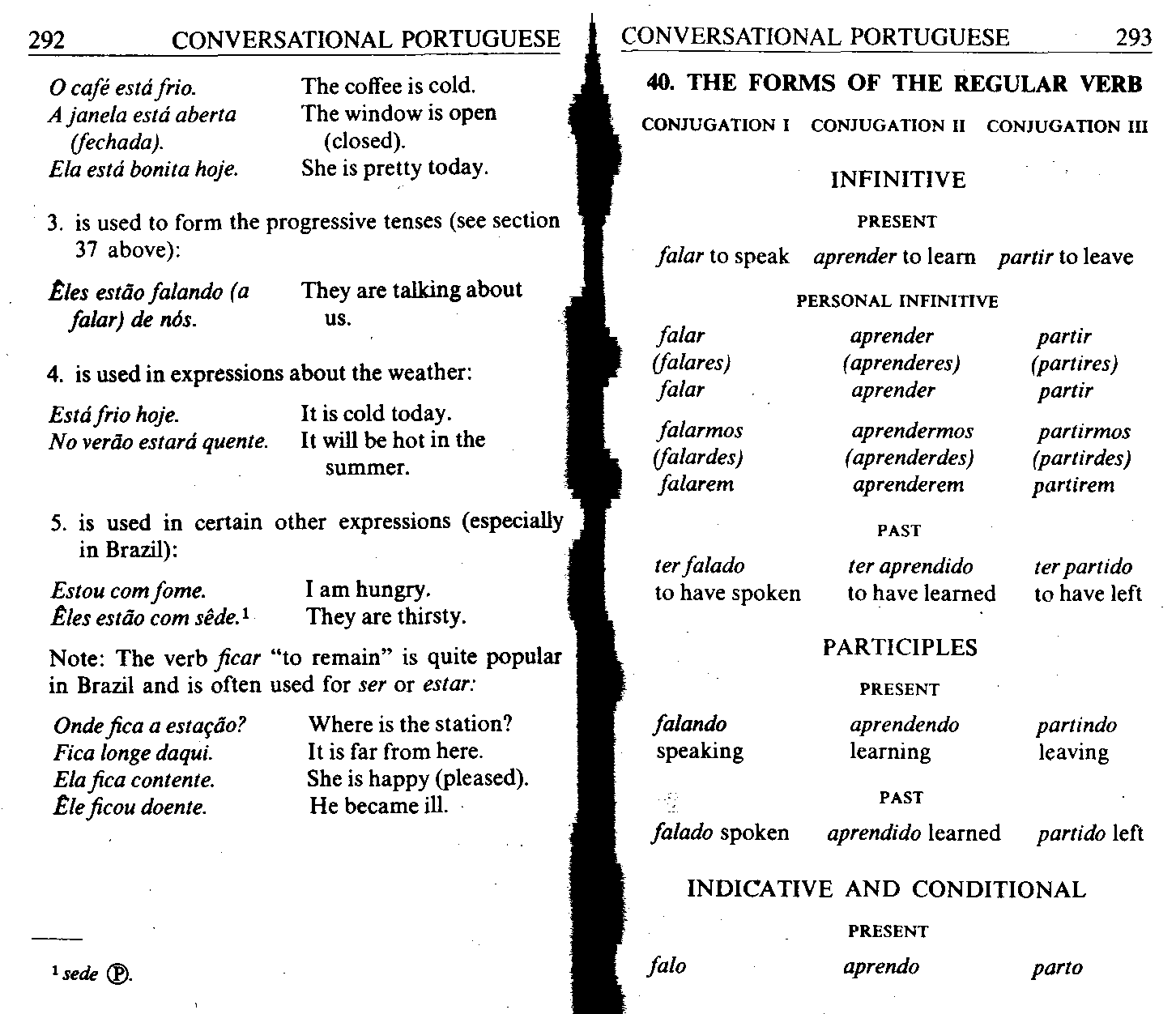Summary p292

292 CONYERSATIONAL PORTUGUESE
O cafe estd frio.
A janela estd aberta (fechada).
Ela estd bonita hoje.
The coffee is cold, The window is open (closed).
She is pretty today.
3. is used to form the progressive tenses (see section 37 above):
Eles estdo falando (a falar) de nós.
They are taiking about us.
4. is used in expre$$ions about the weather:
Estd frio hoje.
No verao estard ąuente.
It is cold today.
It will be hot in the summer.
5. is used in certain other expressions (especialły in Brazil):
I am hungiy. They are thirsty.
Estou com forne.
Eles estdo com sede.1
Notę: The verb ficar ‘‘to remain” is quite popular in Brazil and is often used for ser or es tar:
Onde fica a estaędo? Fica longe daąui.
Ela fica contente. Ele ficou doente.
Where is the station?
It is far from here.
She is happy (pleased). Hebecameill.
40. THE FORMS OF THE REGULAR VERB
CONJUGATION I CONJUGATION II CONJUGATION III
INFINITIVE
PRESENT
falar to speak aprender to leam partir to leave PERSONAL INFINITIYE
|
falar |
aprender |
partir |
|
(falares) |
(aprenderes) |
(partires) |
|
falar |
aprender |
partir |
|
falarmos |
aprendermos |
partirmos |
|
(falar des) |
(aprenderdes) |
(partirdes) |
|
falarem |
aprenderem |
partirem |
|
PAST | ||
|
ter falado |
ter aprendido |
ter partido |
|
to have spoken |
to have leamed |
to have left |
|
PARTICIPLES | ||
|
PRESENT | ||
|
falando |
aprendendo |
partindo |
|
speaking |
learning |
leaving |
|
PAST | ||
|
falado spoken |
aprendido learned |
partido left |
INDICATIVE AND CONDITIONAL
PRESENT
falo aprendo parto
sede
Wyszukiwarka
Podobne podstrony:
Summary p222 222 CONYERSATIONAL PORTUGUESE 21. Vamos_(to have dinner). a. jantar
Summary p224 224 CONYERSATIONAL PORTUGUESE (3) variations occur in different areas: a.
Summary p226 226 CONYERSATIONAL PORTUGUESH CONYERSATIONAL PORTUGUESE 227 d g g h j I I Ut m as d i
Summary p230 230 CONYERSATIONAL PORTUGUESE 3, The cedilla (cedilha) is used with
Summary p234 234 CONYERSATIONAL PORTUGUESE k. with parts of the body and articles of clothing inst
Summary p236 236 CONYERSATIONAL PORTUGUESE De and em combine with the demonstrative forms (see GS2
Summary p238 238 CONYERSATIONAL PORTUGUESE 13. MASCULINE AND FEMININE 238 CONYERSATIONAL PORTUGUES
Summary p240 240 CONYERSATIONAL PORTUGUESE 14. THE PLURAL 1. Nouns ending in a vowel, including na
Summary p242 242 CONYERSATIONAL PORTUGUESE seu can also be used to translate “his,” “her,” “their.
Summary p246 246 CONYERSATIONAL PORTUGUESE 1«. COMPAR1SON 1. Rcgular comparison facil easy ma
Summary p248 248 CONYERSATIONAL PORTUGUESE 19. PRONOUNS Pronouns have varying forms depending on w
Summary p250 250 CONYERSATIONAL PORTUGUESE CONYERSATIONAL PORTUGUESE_ 251 (te) I
Summary p254 254 CONYERSATIONAL PORTUGUESE Nao me escreva mais. Eles decidiram que nos mandar
Summary p256 256 CONYERSATIONAL PORTUGUESE 21. SOME CONJUNCTIONS ainda que assim que ate
Summary p258 258 CONYERSATIONAL PORTUGUESE 23. ADYERBS 1. Some Portuguese adverbs are formed by ad
Summary p260 260 CONYERSATIONAL PORTUGUESE la (acold) there (morę remote) adiante . forward,
Summary p262 262 CONYERSATIONAL PORTUGUESE sabdo soap sabonete a cake of toilet
Summary p264 264 CONYERSATIONAL PORTUGUESE Ndo ąuero este sem I don’t want this one
Summary p266 266 CONYERSATIONAL PORTUGUESE27. NEGATION 1. Ndo “not” comes before
więcej podobnych podstron